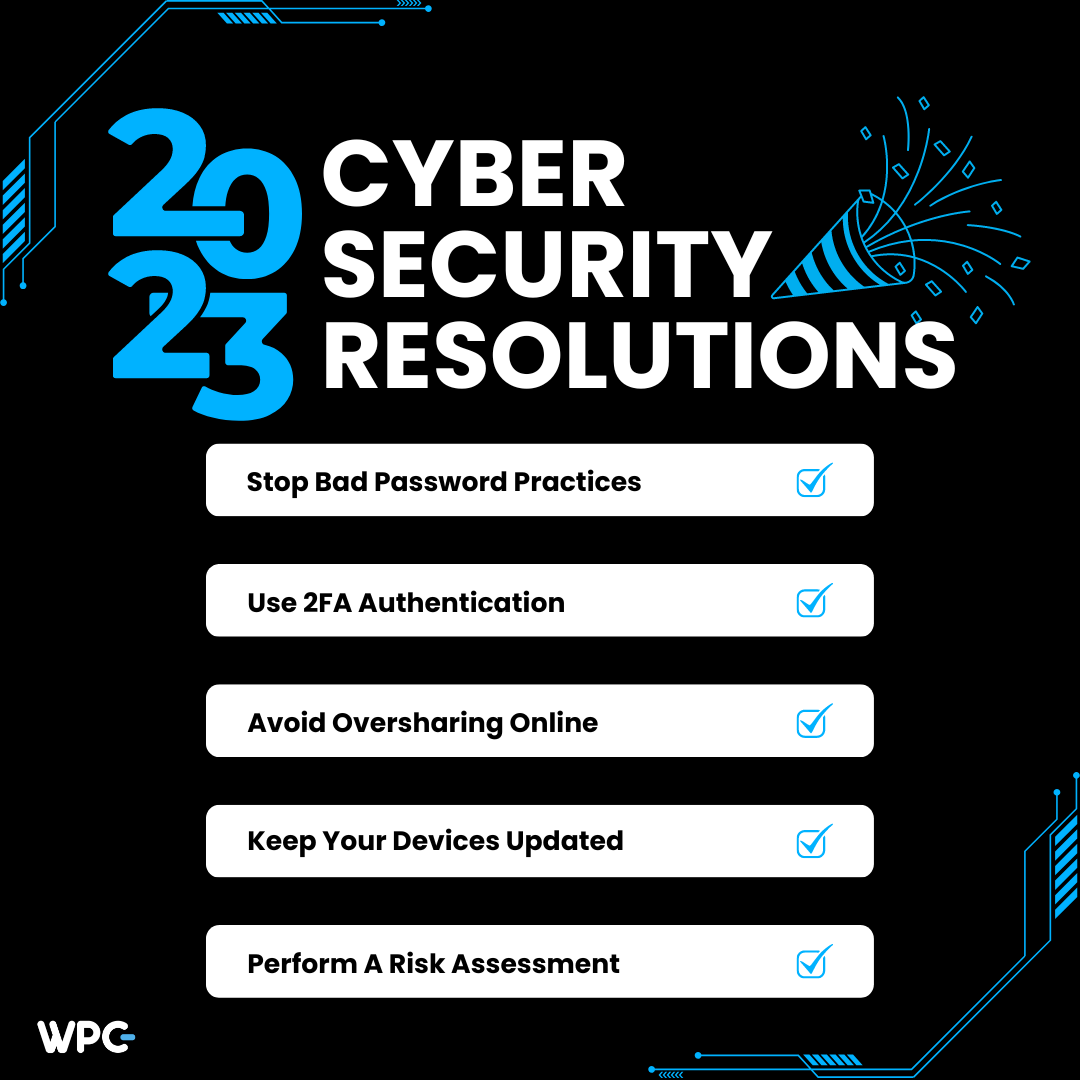People typically prepare for the New Year by creating a list of things they need to improve on based on what they have discovered throughout the previous year.
When it comes to cybersecurity, the same is true. You can improve your ability to defend yourselves against fresh threats by building on what you’ve learned during the previous year.
We have compiled a list of resolutions that don’t call for you to start working out or eating less sugar. We’ve provided some recommendations for actions you may take to increase your cyber preparedness and secure your online activities.
Cybersecurity Resolutions:
Following are some Cybersecurity Resolutions we should take.
Stop Bad Password Practices
Passwords will remain popular despite the emergence of fresh concepts and alternatives. In 2023 and for many years after that, you will have to cope with them. Making appropriate use of passwords and avoiding popular but dangerous cybersecurity activities are therefore smart places to start.
“123456” and “password” are two of the most widely used passwords worldwide in 2022. The same password is used for several accounts, according to 53% of respondents, according to a survey by identity business SecureAuth.
They are exemplary cases of poor password hygiene that can endanger user data and account control. Here are some easy actions you may do to improve your personal cybersecurity if you’re in a similar situation:
- Use different passwords for different websites. According to SecureAuth, more than 53% of online users do this for convenience. Although you should never use identical passwords to protect sensitive information, it’s not a major issue for websites that don’t contain personally identifying information, financial information, or healthcare records. Criminals can employ bots to visit thousands of financial, government, and healthcare sites to test those very same credentials after they link a decrypted password with a username. You might be at their mercy if you made a mistake and utilized the same password for internet banking and a free news website.
- Avoid using simple substitutes. Many websites have requirements for password security, including minimum lengths, upper- and lower-case character combinations, and unique symbols. Simple substitutes, such as “P@$$w0rd,” can fulfill these requirements, but you should resist the urge to do so. Because password-cracking software is made to check for these frequent swaps first, your cunning strategy will only be a little inconvenient. Utilizing less obvious substitutes, such as “>” for the letter “a,” is a preferable strategy.
- Never use personal data as a basis for a password. Avoid using your name, the names of your family, the dates of your birth, street locations, cities, or even your pet’s name as a password. These details are taken from social networks by attackers, who then input them into password-cracking software to produce likely password combinations.
Whenever Possible, Use Two-factor Authentication
To guarantee that only authorized users have access to their online accounts, 2FA is an extra security measure. A user will initially type in their username and password. So, rather than immediately receiving access, they will need to offer more details. To accomplish this, they use a different method of identification verification with you, like biometrics or code words.
Modern cybersecurity must include 2FA since it lowers the dangers associated with password theft. Additionally, 2FA actively involves individuals in the process of staying secure and fosters an environment where users are informed about their own digital safety, all of which are critical for keeping a strong security posture.
A user must respond to the query “Did I request that, or is somebody trying to get into my account?” when they receive a 2FA message. This emphasizes how crucial security is in every transaction. With 2FA, users and administrators work together to secure the website, as opposed to the majority of existing web security techniques that are passive and don’t include users as partners.
Avoid Oversharing Online
A rising amount of information is being shared online, and while many individuals may be aware to keep stuff like Social Security numbers private, it could still be used against you. This private information may make it simpler for fraudsters and hackers (BBB). Think twice before revealing details like your entire name, date of birth, present employer, names of relatives, and obviously, your home address.
However, there is also data that a lot of us casually exchange that could provide cybercriminals with solutions to your password recovery queries. Consider carefully before posting information about your birthplace, marital status, places of attendance, and even the name of your pet on social media. When figuring out the answers to those security questions, identity thieves and cybercriminals may take this data as a starting point.
The first principle of the internet is that once something is online, it stays online.
We should be able to exchange knowledge more thoughtfully and intelligently if possible. Make sure that as few people as possible can see your posts by adjusting your privacy settings. Consider creating separate accounts for the general public and the people you trust.
Keep Your Devices Updated
An enormous amount of software is run by modern mobile devices. This includes the operating systems Android and iOS as well as the programs we download to perform practically every task, from word processing to photo editing and music recording.
Humans write the software. That implies that human error is possible in the underlying code. Malicious hackers may occasionally use these faults, which are also known as software vulnerabilities, to their advantage. When they become notified of those cybersecurity flaws, the majority of device manufacturers and application developers will continue to release patches. They are crucial because they close security holes that hackers can exploit to seize control of your devices and access your information.
While many apps and devices can automatically install updates, there are situations when the user must do a little extra work. To remove known vulnerabilities, keep an eye out for new releases of your applications and operating system and update them as soon as they are made available.
Perform A Risk Assessment
The environment for threats is continuously shifting. With modifications to their operations, structural configurations, technology, and other factors, the majority of businesses are also in a state of change. A crucial cybersecurity resolution for the new year is to do a yearly risk assessment.
A risk assessment is a detailed examination of your workplace to find any elements, circumstances, procedures, etc. that could be harmful, especially to humans. Following identification, you assess the risk’s likelihood and seriousness. You can then decide what steps need to be taken to successfully eliminate or manage the harm once this assessment has been made.
The goal of the risk assessment is to identify hazards, remove them when needed, or reduce the level of risk they pose by implementing management measures.
Your business can make future plans after it has a current understanding of the difficulties it encounters. To be safe in the upcoming year, you need to strengthen your security strategies and policies.
SECURE THE YEAR AHEAD WITH WORKPLACE CONNECT
Risks associated with cyber security can have a disastrous impact on both your personal and professional lives. Contact us today for professional advice to get ready for a new year when cyber threats will likely develop and multiply.
We acknowledge that most users don’t become accustomed to these safe practices overnight. That’s why at Workplace Connect, we offer services and products that are beginner-friendly and designed to protect even non-tech-savvy people. Give it your top priority so your accounts and data can enjoy world-class protection from 2023 onwards.
Don’t let cyber threats ruin your year – take action now and protect yourself online!
Wishing everyone a very Happy New Year!







